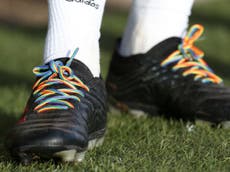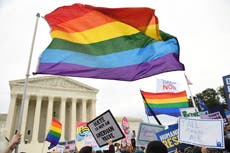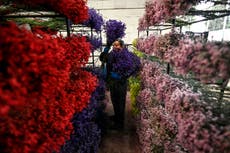Why we need to think carefully before flying the rainbow flag for the NHS
After a year of the coronavirus pandemic, spotting the flag no longer fills me with joy – it makes me uneasy


Your support helps us to tell the story
From reproductive rights to climate change to Big Tech, The Independent is on the ground when the story is developing. Whether it's investigating the financials of Elon Musk's pro-Trump PAC or producing our latest documentary, 'The A Word', which shines a light on the American women fighting for reproductive rights, we know how important it is to parse out the facts from the messaging.
At such a critical moment in US history, we need reporters on the ground. Your donation allows us to keep sending journalists to speak to both sides of the story.
The Independent is trusted by Americans across the entire political spectrum. And unlike many other quality news outlets, we choose not to lock Americans out of our reporting and analysis with paywalls. We believe quality journalism should be available to everyone, paid for by those who can afford it.
Your support makes all the difference.Since the start of the Covid-19 pandemic, I’ve seen more rainbow flags than I can count.
For 40 years the flag has been flown on safe spaces, establishments where the LGBT+ community can be free of judgement and prejudice. But in the past year, I’ve seen the flag on five-star hotels, hospitals, car bumpers, dog jackets, even on the doors of public loos.
I do a double take of the flag every time. Years of living and working in different countries as a journalist, often in places where I could be locked up, tortured, or face the death penalty for having a same-sex relationship, makes you very attuned, almost hyper-alert, to a beacon like the rainbow flag. Now that flag exists in a space in the UK where there are two meanings.
“You have an LGBT flag up, amazing,” said one of my friends to their grandma during the first lockdown, while delivering essential supplies. “It’s not a gay flag, it’s for the NHS”, she replied. And herein lies the problem.
At the start of the coronavirus pandemic, I too drew a picture of a rainbow in chalk on the street with my son, we scribbled a cardboard NHS sign with bright felt tips to put in our window in support of the brave frontline workers risking their lives for us. Almost a year later we’re still fighting this awful virus, but spotting the flag no longer fills me with joy, it makes me uneasy.
That’s not to say the NHS is not a deserving cause, I'm extremely thankful for everything the NHS has done – and it deserves all the recognition we can give it.
However, the meaning of the flag has been well and truly watered down, its purpose diluted by the pandemic. No cause, no matter how deserving, should muscle out another, even if the damage was unintentional.
It’s important to say here, the NHS had no say in the use of the rainbow flag. Worldwide, health services have been swept along in this colourful frenzy, just like the rest of us when, understandably, we are scared, and have rallied in support of our heroes. It’s just a real shame the emblem we used wasn’t, well, more original.
In a social media age, movements happen fast, often without a lot of thought. It takes a second to repost a picture of children in Italy drawing rainbows for their health workers. It starts as a cute and innocuous gesture, and before you know it you can buy an iced-caramel latte in a cup with the same design. But it is not like the extensive history attached to the use of the flag by the LGBT+ community wasn’t well known.
During LGBT History Month, it’s time to take stock. Homophobia is still prevalent. Late last year, the BBC obtained figures from 45 police forces in the UK that showed the number of reported homophobic hate crime cases almost trebled – from 6,655 in 2014-15 to 18,465 in 2019-20. Around one in five LGBTQ people will experience a hate crime or incident because of their sexual orientation or gender.
We must consider the significance of the flag and the role it plays for a marginalised community, which has fought hard for its identity and acceptance. Gay rights activist Gilbert Baker designed the rainbow flag in 1978 in San Francisco. He didn’t trademark it as he wanted everyone to be able to use it.
After the assassination of gay San Francisco city supervisor, Harvey Milk, the flag was firmly adopted by the LGBT+ cause, its followers became the “rainbow community”. It’s a community that has long faced oppression – being gay is still illegal in more than 70 countries. Of course, no one owns the rainbow, but the flag is more than a symbol of hope – it’s a symbol of safety. That’s why from now on I’ll be displaying a big blue heart in my window for the heroes of the NHS.
Any erosion of the distinguishing marks of the LGBT+ community needs to be resisted. A number of LGBT+ venues across the country are are struggling thanks to the economic effects of the pandemic and I don’t think suffocating the flag will help. When this is over, I still want to recognise the guesthouses, pubs, and venues where I can feel safe and accepted.
So fly the rainbow, fly it high – but remember the history behind it. The fight for equality is far from over.



Join our commenting forum
Join thought-provoking conversations, follow other Independent readers and see their replies
Comments